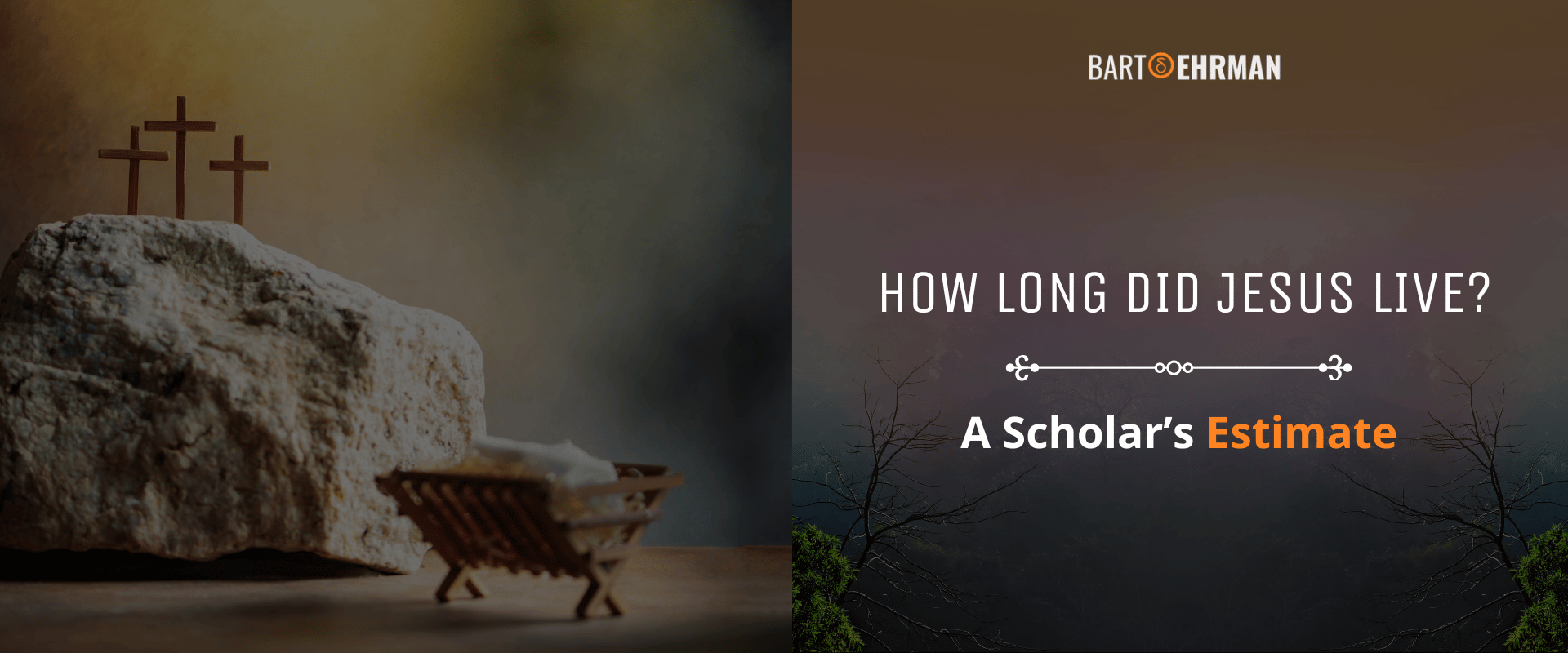How Long Did Jesus Live? A Scholar’s Estimate

Written by Joshua Schachterle, Ph.D
Author | Professor | Scholar
Author | Professor | BE Contributor
Verified! See our editorial guidelines
Verified! See our guidelines
Edited by Laura Robinson, Ph.D.
Date written: October 19th, 2024
Disclaimer: The views and opinions expressed in this article belong to the author and do not necessarily match my own. - Dr. Bart D. Ehrman
How long did Jesus live? That question has fascinated scholars and believers alike for centuries. Despite the abundance of religious texts and traditions surrounding his life, pinpointing his exact age at death is a complex task steeped in historical ambiguity and conflicting accounts.
In this article, I’ll examine various scholarly speculations and debates surrounding Jesus' birth, ministry, and death, sifting through ancient sources and modern scholarship to offer a reasonable estimate of his age at the time of his crucifixion.

Life Expectancy in Jesus’ Time
Scholars generally believe that the average life expectancy in the 1st century Mediterranean world was around 35 years. However, this is highly misleading for a few reasons explained by Karen Cokayne in her book Experiencing Old Age in Ancient Rome.
(Affiliate Disclaimer: We may earn commissions on products you purchase through this page at no additional cost to you. Thank you for supporting our site!)
Cokayne notes that the average life expectancy in Jesus’ time was low partly because of extremely high rates of infant and early childhood mortality. In fact, she says that approximately one third of infants died before the age of one, while around half of all children died before the age of ten. This clearly affects the average.
Cokayne goes on to write that those who survived to the age of 10 could expect to live to approximately the age of 45. Those who lived to the age of 60, on the other hand, could reasonably expect to live to the age of 70. All of these theoretical statistics point to a 1st-century world in which those who survived childhood could live relatively long lives.
However, there were far more dangers to face in the 1st century even if one survived childhood. In The Impact of Jesus in First-Century Palestine, Rosemary Margaret Luff writes about archeological evidence from human bones found in Jerusalem and Jericho. In one example, the bones of a wealthy man showed evidence of both leprosy and tuberculosis, both of which were common and either of which could have killed him. Another wealthy man’s bones showed evidence of a severe tapeworm infection. Additionally, according to Robert Woods, maternal deaths in childbirth happened as often as 30% of the time in the ancient world.
Ultimately, it is impossible to make a firm calculation of how long most people lived in Jesus’ time. However, while some people definitely lived into their 60s and 70s, the majority of the population probably did not.
What other factors contributed to Jesus’ life and ministry? Let’s take a closer look at where he came from.
Political and Cultural Context of Jesus’ Life
Jesus spent his formative years in Nazareth, a tiny hamlet in the northern Palestinian province of Galilee. The vast majority of his preaching also happened there. What do we know about the politics and culture of Galilee during the 1st century?
For one thing, Allan Callahan says that Galilee had a reputation as a hotbed of political activity. For example, in 4 BCE, there was a major revolt against Roman taxation in the city of Sepphoris, not far from Nazareth. First-century Jewish historian Josephus writes that, in response, the Roman governor of Syria ordered the military to sack the city and sell its entire population into slavery. It’s likely that Jesus, growing up in nearby Nazareth, knew about this incident which happened not long before his birth.
Culturally, Galilee was overwhelmingly Jewish. Mark Alan Chancey and Adam Lowry Porter write that archeological evidence from Jesus’ time shows “Jewish customs, including the use of limestone vessels, ritual baths for purity, and secondary burial practices.”
Overall, Jesus grew up in a deeply Jewish and politically tense place. It is highly likely that both these factors influenced his ministry.
Now that we have some context, let’s begin asking the question “How long did Jesus live?” by examining what we know about the chronology of his life, starting with the year of his birth.
FREE COURSE!
WHY I AM NOT A CHRISTIAN
Raw, honest, and enlightening. Bart's story of why he deconverted from the Christian faith.
Over 6,000 enrolled!
How Do Scholars Date Jesus’ Birth?
The Gospels are imperfect historical references. While they certainly carry historical memories, they rarely, if ever, place them in history in a way that is easy or logical for modern readers to calculate. However, let’s take a look at what chronological information they give us about Jesus’ age.
The difficulty begins with the fact that only two of our four canonical Gospels, Matthew and Luke, say anything about Jesus’ birth. Matthew 2:1 says Jesus was born “in the time of King Herod,” referring to Herod the Great, who reigned from 37 BCE to 4 BCE. Matthew 2:16 then says that Herod killed all children under the age of two in Bethlehem, indicating that Jesus might have been born about two years before this incident (Historical evidence does not support Herod’s dastardly deed). Finally, while Jesus is still a small child, Matthew 2:19 says Herod died. If Jesus really was born approximately two years before Herod’s death, which occurred in 4 BCE, his birth would have occurred around 6 BCE.
Luke 1:5 also sets Jesus’ birth during Herod’s reign. However, Luke also connects his birth with a census given by a governor of Syria named Quirinius, a census which didn’t happen until 6 CE. In other words, it occurred when Herod had already been dead for a decade. Later, Luke 3:1 dates the beginning of John the Baptist’s ministry to the fifteenth year of the reign of the emperor Tiberius, which gives us a date of 29 CE. Finally, Luke 3:23 says that Jesus was “about 30” at the start of his own ministry. Since we don’t know for sure how long John’s ministry lasted, this would put Jesus’ birth at no later than 1 BCE.
Given this scanty and contradictory information, John Meier, in his massive book A Marginal Jew: Rethinking the Historical Jesus, notes that most scholars place Jesus’ birth between 6 BCE and 4 BCE. It’s not a precise calculation, but it’s a reasonable place to start when calculating how long Jesus lived.
If we also accept Luke’s assertion that Jesus was around 30 years of age when he started his ministry, as well as his assertion that John the Baptist’s ministry started in the 15th year of Tiberius’ reign, this gives us a date of 29 CE when his ministry began.
However, in answering the question “How long was Jesus on earth?,” we still need to look at how long his ministry lasted. This is more complicated than you might think.

How Long Was Jesus’ Ministry?
The Synoptic Gospels only speak about Jesus celebrating one Passover with his disciples before his crucifixion. Since Passover is an annual event, this would seem to indicate that Jesus’ ministry lasted no longer than one year. However, the Gospel of John says that three Passovers occurred during Jesus’ ministry, signifying that it lasted more than two years (most people just assume it was three years). How do scholars deal with this discrepancy?
Bart Ehrman notes that many Christians believe Jesus died at the age of 33, although the Gospels never say this. Ehrman writes that this age was arrived at by combining two pieces of information: First, they take Luke’s assertion that Jesus was “about 30” when he started his ministry and second, they take John’s chronology of three years based on three Passovers during Jesus’ ministry. But since these two pieces of information come from two different sources that contradict each other on the chronology of Jesus’ life, this is not a sound basis for determining his age.
Additionally, Ehrman points out that there is a separate tradition about the length of Jesus’ ministry written about by a 2nd-century author named Irenaeus. In his book Against Heresies, Irenaeus says that it’s heresy to assert that Jesus died in his thirties. Why would he say this?
He points to a passage in John 8:56-57 when Jesus, arguing with Jewish religious leaders, says
Your ancestor Abraham rejoiced that he would see my day; he saw it and was glad.” Then the Jews said to him, “You are not yet fifty years old, and have you seen Abraham?
Irenaeus says that this indicates that Jesus must have been in his 40s — “not yet fifty years old” — by the time he was crucified. He says that Jesus’ challengers would not have put it this way if Jesus were merely in his early 30s. If this were true, it would indicate that Jesus’ ministry lasted almost 20 years. Most scholars don’t take Irenaeus’ argument seriously, but it is an interesting idea that was clearly circulating in the 2nd century.
The final piece of our puzzle involves determining the year of Jesus’ death.
When Did Jesus Die?
In his book The Death of the Messiah, From Gethsemane to the Grave, Raymond Brown noted that scholars have argued for centuries over when Jesus died. Based on the four Gospel accounts, for example, most scholars agree that he died on a Friday. It’s more difficult, however, to establish the year that he died. What information do we have about this?
We know from all four Gospels that Jesus was put to death by the Roman official Pontius Pilate. Even non-Christian sources, such as Josephus and the Roman historian Tacitus, agree that Pilate was responsible for Jesus’ death. Pilate was governor of Judea from 26-36 CE, so the crucifixion of Jesus had to take place during those years.
If we then take Luke’s date of 29 CE as the start of Jesus’ ministry, most scholars put his crucifixion between the years of 30-33 CE, although it could have occurred as late as 36 CE, in line with Pilate’s tenure in office.
Taking all this evidence together, we can summarize our findings: Jesus was born between 6 BCE and 4 BCE. His ministry probably only lasted about a year, but could have lasted as long as three years. His death occurred during the tenure of Pontius Pilate and likely happened between 30 and 33 CE.
None of this evidence is 100% certain, but if we add it up, Jesus was probably somewhere between the ages of 33 and 39 when he died.
Conclusion: How Long Did Jesus Live?
People have made many assumptions throughout the centuries about how old Jesus was at his crucifixion. Due to the scanty evidence, they filled in the blanks.
While life expectancy was very low in the 1st century compared with today, those who made it past the age of 10 would likely have lived into their 40s at least. Jesus was one of the lucky ones in this respect. Using information from the Gospels, as unhistorical and contradictory as they can be, scholars have reached a consensus that Jesus was born between 6 and 4 BCE.
Growing up in Galilee, Jesus would have been immersed in Jewish culture and religion. He was likely also exposed to the angry political thought of his compatriots against the occupying Romans. We can see both these influences in some of the sayings attributed to him, as well as the fact that he was ultimately killed by a Roman governor.
While Jesus’ ministry lasts about a year in the Synoptic Gospels, John’s Gospel implies, based on the three Passovers it mentions, that his ministry was closer to three years. Unfortunately, there is no way to determine this for certain. Another later tradition even said that it lasted closer to 20 years, based on a quotation from the Gospel of John.
Most scholars agree that Jesus’ death occurred around 30-33 CE. This is based partly on the tenure of Pontius Pilate, the Roman governor who ordered Jesus’ crucifixion, as well as Luke’s estimation that Jesus began his ministry around the age of 30. All of this leaves us with a Jesus who died between the ages of 33 and 39 years old.
FREE COURSE!
WHY I AM NOT A CHRISTIAN
Raw, honest, and enlightening. Bart's story of why he deconverted from the Christian faith.
Over 6,000 enrolled!
